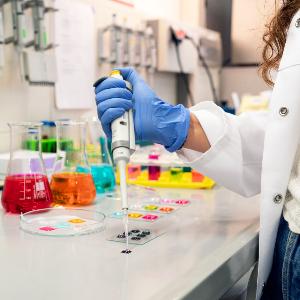Functional architecture that builds itself
25 Sept 2023
A research team from LMU is combining traditional lithographic methods with the self-organization of DNA origami to create organic 3D nanostructures on surfaces.
25 Sept 2023
A research team from LMU is combining traditional lithographic methods with the self-organization of DNA origami to create organic 3D nanostructures on surfaces.

Nanocomponents as organic dyes or nanoparticles bind to the surface of the chips and form 3D molecular architectures. | © Vera Hiendl / e-conversion
Imagine hundreds of Lego bricks coming together and spontaneously forming, say, a house. And then, before you know it, the whole play mat is filled with hundreds of houses. Although this does not work in real life, it can be accomplished effortlessly at the molecular level – provided the conditions are right. Nature has mastered the principle of self-organization by exploiting intermolecular forces and electrostatic attraction. In this way, complex 3D structures with a specific function are seemingly formed by magic. Light-harvesting complexes for photosynthesis or hydrophobic, self-cleaning lotus leaves are two examples. “It’s exactly this principle of self-assembly that we’re adapting for our purposes and using to develop methods for functionalizing surfaces on the nanometer scale. To do this, we combine lithographic methods with DNA origami, enabling us to construct ordered 3D nanostructures,” explains Dr. Irina Martynenko, a postdoctoral researcher in physics professor Tim Liedl’s research group at LMU. The research team has now published its results in the journal Nature Nanotechnology. “The fields of application for nano- and micro-structured substrates are extremely diverse, ranging from microchips and biosensors to solar cells. This makes the principle of self-assembly so advantageous,” observes Martynenko.
The LMU research group led by Prof. Tim Liedl, funded by the e-conversion cluster of excellence, has specialized in DNA origami. In this assembly process, long, single-stranded DNA molecules are present that arrange themselves into the desired shape using shorter pieces of DNA – so-called staple strands. Four nucleobases are crucial for self-assembly, with the combining of adenine and thymine, and guanine and cytosine, as in the double helix structure of DNA. To obtain the 3D architectures, the researchers use a classic top-down method (electron-beam or sphere lithography), which removes as much of a starting material of silicon dioxide or glass until a pre-structured surface is created. “In this way, we create regularly structured docking sites for the subsequent layer – in this case, the DNA origami,” Martynenko says. “Before, only two-dimensional arrangements could be created. Now we’ve produced a variety of 3D structures, such as tubes, donut-shaped rings, and tetrapods, which then arrange themselves on the previously created binding sites,” explains the LMU postdoc.

Nanoscale 3D structuring becomes cheap and can be performed in principle without a clean room, Irina Martynenko says. | © Vera Hiendl / e-conversion
Preparation of 3D DNA nanotextured surfaces is quite simple. First, the researchers prepare the patterned substrates with sticky binding sites in a 50-100 nanometer size range. Next, the 3D origami is folded in a plastic vial – billions of them arranged in parallel without human intervention. Afterward, they place tiny droplets of the 3D DNA origami on the pre-patterned surface. There, the 3D shapes self-align on the pre-determined binding sites. “We can control the 3D alignment of the shape and even keep the cylindrical tubes vertical. The dimensions of the tube walls are extremely small, measuring just ten nanometers in thickness. Producing such tiny 3D structures with conventional lithography requires expensive equipment and a clean room. Using the self-assembly process we employed – DNA origami and sphere lithography – nanoscale 3D structuring becomes cheap and can be performed in principle without a clean room,” Martynenko explains. The researchers use a trick to make the assembled architectures of the sensitive organic molecules more robust. They create a silica layer around the DNA shapes as a protective shell, thereby stabilizing the structures. Thanks to this silicification, the 3D patterned surfaces can withstand temperatures up to 500 degrees Celsius.
One feature that makes this DNA-based approach unique is the molecular addressability of the origami structures. That is to say, every DNA strand of every structure can be equipped with functional chemical groups. Martynenko illustrated this nanometer-precise control by placing nanometer-scale gold particles on precisely defined sites on their structures. Producing such nanotextured surfaces using lithographic methods or classic 3D printing techniques alone is either prohibitively difficult or impossible. As such, the Liedl research group’s DNA origami offers a promising approach for various practical innovations, such as producing more powerful solar cells. “Harnessing assembly precision alone could help increase the efficiency of active layers,” explains the LMU researcher. “For example, we’re working on preparing vertical stacks of the molecules as a means of generating directed pathways for electron transfer. Our model systems could then be used to optimize charge exchange and thus the performance of solar cells,” says Martynenko, offering a glimpse into the future.
Irina V. Martynenko, Elisabeth Erber, Veronika Ruider, Mihir Dass, Gregor Posnjak, Xin Yin, Philipp Altpeter, Tim Liedl: Site-directed placement of three-dimensional DNA origami. Nature Nanotechnology 2023